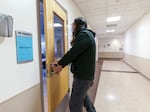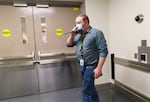Editor’s note: Throughout 2023, OPB is taking a deep look at the biggest social and economic challenges facing Oregon today – their origins, their impacts and possible solutions. This week we are looking at the gaping holes in the state’s mental health system, including how Oregonians with the most serious mental illnesses often have inconsistent access to services and housing options.
Oregon’s system for people with profound mental illness is broken. Below, we explain the roots of two major problems and explore two promising strategies that could address these issues.
PROBLEM ONE: Some people with the most serious mental illnesses cycle between Oregon’s public psychiatric hospital, county jails and homelessness.
People with serious mental illnesses often receive treatment for a time and then drop out or discontinue it.
Here’s what too frequently happens next: Without treatment, some mentally ill people deteriorate and end up homeless. An arrest – easy to come by when living on the streets – can land them in county jail. Unable to stand trial due to psychosis, they’re sent to the Oregon State Hospital on a court order to be treated.

Patients fill in their answers to the prompt, “I dream to someday…” in a hallway at the Oregon State Hospital in Salem, March 8, 2023.
Kristyna Wentz-Graff / OPB
While they’re at the Oregon State Hospital, they get medication, therapy and a safe environment. Most people staying in the Salem psychiatric hospital are also isolated from friends and family. It’s an hour drive for visitors from Portland and much further for people from the east side of the Cascade Mountains or the southern part of the state. Patients are also often cut off from any therapists or health care providers they had been seeing before because of a rule in the federal Medicaid statute. And in any case, the majority of patients can only stay until they’re well enough to understand the charges against them and stand trial.
Though some have to leave before they have hit even that relatively low bar for wellness. As of September 2022, people accused of felonies can be held for treatment for a maximum of one year. For misdemeanors, the maximum stay is 90 days.
Some people are eventually able to stand trial. Others are found to be never able to understand the charges against them. Prosecutors pursue “guilty but for insanity” verdicts in the most serious cases. Less serious charges are dropped, and a person is discharged to a hospital, to the street or to the oversight of a county mental health department. Often, they end up homeless. Then the cycle repeats.

A hearing room at the Oregon State Hospital in Salem, March 8, 2023, where patients may attend a virtual court appearance.
Kristyna Wentz-Graff / OPB
“We’ve become very dependent on the criminal punishment system as our de facto mental health system,” said Jesse Merrithew, a civil rights attorney who is part of a high-profile lawsuit over delays admitting patients to the state hospital. “It doesn’t make sense clinically. Doesn’t make sense morally.”
PROMISING STRATEGY: A statewide program to assess and assist people ages 12 to 25 who are in their first year of experiencing psychosis could result in early and more successful treatment for people with the most serious mental illnesses.
One statewide program aims to intervene far upstream of the revolving door cycle by helping people maintain their sense of identity, family and agency through the initial onset of a mental illness.

“I think there's a misconception that like, if you're having a mental health issue your life is just done,” says Nybelle Caruso, 30, who experienced a medication induced psychosis at age 20.
Kristyna Wentz-Graff / OPB
The Early Assessment and Support Alliance focuses on people with schizophrenia and bipolar disorder with psychosis.
For many who have these disorders, symptoms begin in their late teens or twenties. Without early intervention, young people first developing a mental illness that involves psychosis will often spend one to two years after their symptoms start before getting any treatment. That delay can upset the course of their lives, disrupting their chance of finishing school, finding a job and maintaining family ties.
“These conditions can lead to the dissolution of a family pretty rapidly,” said Tamara Sale, who runs the Early Assessment and Support Alliance Center for Excellence at the OHSU-PSU School of Public Health. ”It can lead to them being kicked out in the street because their families [are] trying to draw boundaries.”
When people do finally receive treatment, it’s sometimes in the form of involuntary civil commitment, which is difficult to obtain, controversial and increasingly rare. But people have a better shot at recovering if they get early treatment and support, experts say. That’s because most people who experience psychosis due to a mental illness like schizophrenia or bipolar disorder have initial symptoms that are milder, Sale said.

Tamara Sale, director of the Early Assessment and Support Alliance Center for Excellence (EASA) at the OHSU-PSU School of Public Health.
Kristyna Wentz-Graff / OPB
“There’s a window where we can identify and interact with the person before it’s gotten to that really acute level,” Sale said.
In the early stage, people start to experience changes in their sensory perceptions and new ideas that don’t make sense to other people. They are also more likely to consider suicide during the early onset phase.
“They are met with a lot of misunderstanding,” Sale said.
Crucially, during this early period, people are often relatively motivated to figure out what’s happening to them and receive treatment.
But for many people, navigating the rules of the health care system and insurance feels impossible. It requires people to show up on time to appointments and be organized at a time when they are losing those abilities.
“If you think about a program for people in wheelchairs being placed on the second story of the building with no elevator and no ramp and no outreach,” Sale said. “That’s kind of how the mental health system has been set up.”
Sale says it’s easy for a person experiencing the first onset of a mental illness to be mislabeled as lazy or pressured to perform.
“Other people don’t understand how hard they’re working,” Sale said.
This is where the Early Assessment and Support Alliance, EASA for short, comes in. The program is set up to accommodate the needs of people who have experienced psychosis, and to show them that the mental health system can be a friend, not the enemy.
Similarly to the Intercept program for children experiencing mental illness, EASA program staff come to people’s homes and work with their families to figure out how to connect with a person and engage them in treatment.

Sam Skinner of Hood River snorkels in the Columbia River at Marina Park in Hood River, March 6, 2023. Skinner received critical care from the Early Assessment and Support Alliance Center for Excellence (EASA) after a period of psychosis in 2018.
Kristyna Wentz-Graff / OPB
Program staff will spend time getting to know the person, and will communicate with them in whatever way feels safe. For someone experiencing paranoia, that might mean speaking on either side of a closed door, or exchanging handwritten notes. In the short term, the goal is to get each participant to the point where they can put their thoughts together well enough to participate in decisions about their course of treatment.
Another distinguishing feature of the program is its approach to antipsychotic medication. Taking medication isn’t a requirement of the program, and when meds are used, clinicians focus on getting the dosing right for each participant.
“If we identify people a little earlier, it’s easier to focus on a start low, go slow approach.”
Some people, Sale said, do need medication and may need help working through the grief associated with that decision. While many antipsychotic drugs are effective for most people, they are controversial because they can be sedating and cause heart problems, among other issues.
The program uses strategies to help people who want to minimize the dose that they’re on. A person might opt for a dose that’s just enough to stop scary hallucinations, but that doesn’t completely eliminate the voices in a person’s head, if those voices are friendly.
The program teaches skills that can reduce the symptoms of psychosis, like getting adequate sleep and regulating stress. And it helps people understand the often predictable pattern of their illness.
“If they can understand what their personal pattern is, they can often prevent it from progressing,” Sale said.

Emily Nguyen, 26, practices skating in Evelyn Schiffler Memorial Park in Beaverton, March 6, 2023. While struggling with her mental health in 2018, Nguyen received support from the Early Assessment and Support Alliance Center for Excellence (EASA). She graduated from the two year program, and now works for EASA as a service coordinator and part of the young adult leadership council.
Kristyna Wentz-Graff / OPB
People typically stay enrolled in EASA for about two years. Sale says the program is still figuring out which metrics to use to measure success, but some numbers suggest it has a stabilizing effect. The likelihood of a person being hospitalized drops while they are in the EASA program. About 60% of participants are in school or are working when they start EASA, and roughly the same percentage are still enrolled or employed at the end.
Sale says genuine recovery from psychosis is possible, and EASA graduates have gone on to careers in college admissions, law and medicine.
“I think our society really needs them,” she said, “and it’s a huge loss for them not to be able to participate.”
Sale says the metric that matters the most to her is that graduates are able to live full lives.
PROBLEM TWO: There are nowhere near enough group homes, residential care facilities or supportive housing options for people living with mental illness or addiction.
In 1995, Oregon closed the Dammasch State Hospital after Disability Rights Oregon publicized the deaths of five patients and the inhumane living conditions there. For years, Oregonians with mental illnesses had lived at the psychiatric institution heavily sedated and in the dark. Eager to find a better way to treat people with mental illnesses, advocates urged the state to replace the Wilsonville hospital with smaller-scale housing and community treatment programs across the state so that people could remain integrated in their communities while receiving the care they needed.

An aerial view of Dammasch State Hospital in Wilsonville, 1960. The facility had 460 beds and accepted patients in March of 1961.
Oregon State Archives
Flash forward 28 years: That promised community treatment system still barely exists.
Instead, legislators spent $311 million remodeling the state psychiatric hospital in Salem in 2013 and $83 million building a new satellite campus in Junction City in 2015. Those expansions were made over the objections of many people working in mental health care.
“We were so frustrated with all this focus over in the valley on the state hospital remodel,” Dr. Robin Henderson, the chief executive for behavioral health for the Providence health system in Oregon, said of that effort. “What we want is the rest of the system.”
As housing costs rose during the last 20 years, it became harder for people struggling with mental illness to afford housing, especially for those on a disability income. That made the need for subsidized or free housing more urgent. But it also made finding affordable housing for people with serious mental illnesses even harder.
And then the pandemic struck. That too exacerbated the housing problem. COVID-19 outbreaks and staffing shortages led a number of adult foster care homes and skilled nursing homes to close or cut back the number of patients they worked with.
For example, in one of the state’s earliest COVID-19 outbreaks, more than 30 people died at a Southeast Portland nursing home, Health Care at Foster Creek. Facing lawsuits and the loss of its state license, the 115 bed facility closed in May 2020.
Health Care at Foster Creek had been one of the places Oregon’s Department of Human Services had placed seniors with serious mental illness, using funding from Multnomah county’s community mental health program.

Many facilities that housed people with serious mental illness, such as Foster Creek in Southeast Portland, have closed. Foster Creek was the scene of a deadly outbreak of COVID-19, and the 115 bed facility closed in May 2020.
Bradley W. Parks / OPB
“Many of the places that we sent people in 2019 aren’t here anymore,” Henderson said.
Residential care facilities can choose who they admit, and can turn people away for having the wrong health insurance, for being “too acute,” or for particular behavioral issues.
The current situation is akin to a buyers market, where “the people who have the housing options can be pickier,” Henderson said. That means some patients are frequently rejected and struggle even more to find a stable place in the community.
PROMISING STRATEGY: More small facilities statewide would allow more people to live stably in their communities.
Emily Cooper, with Disability Rights Oregon, says the state’s north star should be providing in- home support and hands-on outpatient treatment so that people with mental illness can live as independently as possible.
“We need more services in the community, period, the end,” Cooper said.
Henderson said the state also needs more “step-down” residential facilities that can treat people with serious mental illnesses after an acute illness and hospitalization, and provide them with a safe environment for long enough to allow them to get stable.
“Ninety-seven percent of people who enter into some type of facility like that, should be able to go back out and reintegrate into the community,” she said.
There’s a distinct advantage to scaling down any new residential care facilities for psychiatric patients. A federal rule that dates back to the 1960s means the state could only use federal Medicaid match dollars for inpatient psychiatric patients in facilities of 16 people or fewer, though the state health authority recently received a waiver from Medicaid that allows for some exceptions for facilities that treat substance use disorders.
At a hearing in December, lawmakers asked then director of the Oregon Health Authority, Patrick Allen, what would alleviate the admissions crisis at the Oregon State Hospital. Allen’s answer was that the state needed to invest more in community services.
“More of everything,” is how Allen described what was needed.
In the last session, the legislature made a down payment on solving the housing and residential care problem.
It allocated $130 million for the acquisition, renovation and start-up expenses of supportive housing and licensed residential treatment facilities, and for “community-based residential settings for individuals with a serious and persistent mental illness requiring a higher level of care.”
Another $100 million in one-time funding went to help county mental health programs pay for short-term housing support, including funding for shelter beds and rental assistance.
The Oregon Health Authority completed its review of proposals this month, and has awarded grants for 16 residential treatment homes adding 122 beds and nine supportive housing projects adding 160 new units.
The health authority wasn’t able to share a list of the projects that have been funded.
The health authority spokesperson said they prioritized rural areas where the need for housing is the greatest. The projects “will help relieve the bottleneck of individuals waiting to be released from the Oregon State Hospital,” said health authority spokesperson Timothy Heider.
The legislature’s one-time investment may help stand-up new residential facilities, but it won’t cover their annual operating budgets, or ensure they can keep their doors open. The recent changes to the state’s Medicaid program that increase reimbursement rates for behavioral health and allow some larger facilities to bill Medicaid for substance use disorder treatment may help sustain these places in the long run.
Up next: Friday, we’ll examine another challenge in Oregon’s mental health system: the unique stresses and problems in rural Oregon.


































